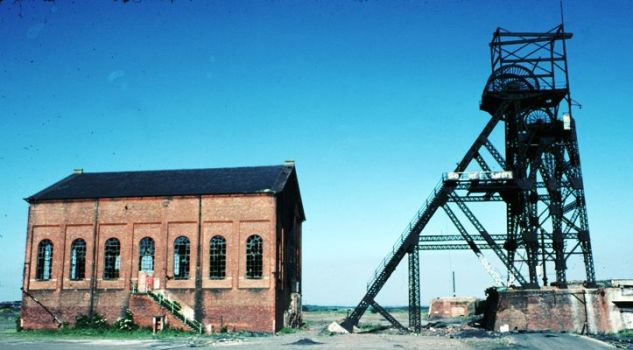This colliery, near Tyldesley, worked a large area of coal under Chat Moss on the western edge of Manchester. To do so, however, the Clifton & Kearsley Coal Co. Ltd had to sink two shafts through 30 metres of peat and water-logged ground. They used the ‘drop shaft’ method for the first time in Britain. This involved forcing tubbing, cylinders of iron with a cutting shoe at the bottom, into the ground using hydraulic jacks. The ground was then excavated before the next section of tubbing was attached and the process was repeated until the 6.4 metres diameter shaft reached the rockhead at a depth of 30 metres. Because the strata remained very wet, the tubbing was continued to a total depth of 122 metres. Below this the strata was stable and dry enough for the shaft to be lined with brick. A large masonry thrust block was built to provide enough weight to resist the force of the hydraulic jacks pushing down the tubbing.
Sinking at No.1 shaft began in May 1908 using a temporary wooden headgear to lift the spoil as well as for transporting men and materials. The pit bottom, at 814 metres, was reached 1912. Because this shaft was to be used for winding around eight tonnes of coal every two minutes from a depth of 801 metres, an impressive lattice steel headgear, nearly 30 metres tall, was built by Head Wrightson, of Stockton on Tees. Completed by 1912 this structure had two winding pulleys, both 6.4 metres in diameter, and weighed 122 tonnes.
The winding engine, which was built by Yates and Thom Ltd of Blackburn, was the largest to be installed in Britain. An identical engine, at Askern Colliery near Doncaster, was demolished around 1981, but the one on No.1 Shaft at Astley survives. This engine, which worked on super-heated steam at 160 psi, developed 3,300 hp from tandem 0.893 m (high pressure) and 1.52 m (low pressure) cylinders by 1.52 m stroke. It was fitted with Corliss valve gear. The bio-cylindrical-conical winding drum, with diameters from 5 to 8.3 metres, wound from a depth of 814 metres.
The headgear on No.2 shaft was of a lighter construction, with rolled steel girders, because it was designed to transport men and materials. The two, three-decked, cages in each shaft were suspended from a wire rope which passed over the headgear pulleys and then down into the engine house to the winding drum. The cages originally held four tubs, but after nationalisation the tubs were replaced with 3 tonne capacity mine cars with one on each deck. No.2 shaft was also fitted with skips taking coal from the ‘Worsley 4 Foot Seam’ to the surface.
The No.2 shaft engine was also built by Yates and Thom, but it was only half the size of the No.1 engine with two cylinders in a cross compound arrangement. The delivery of the engine was delayed by the first world war and it was 1919 before it was ready. By then the Crumbouke, Six Feet and Trencherbone seams were being worked. A large, steam driven fan from Walker Brothers of Wigan stood near the No.2 or upcast shaft. Steam was also used to compress air, for use underground, and to generate up to 3000 kW of electricity.
Yates and Thom also provided 16 Lancashire boilers to raise steam for these engines. The flues to the two chimneys were fitted with economisers which heated the boiler feed water and improved fuel economy. Six boilers were later converted to burn methane tapped from the workings.
On the 7th June 1939 a methane explosion probably caused by a gob fire, claimed the lives of 5 men and injured 5 others. The full report can be found here.
By the late 1960s poor geological conditions made it difficult to produce the required 2½ tonnes per man shift and closure became inevitable. Coal production ended on April 3rd 1970 and demolition was began soon afterwards. Fortunately the No.1 shaft winding house, complete with engine, and the headgear were amongst a small number of features saved. These have been preserved by volunteers and are open to the public. Their collection of 28 colliery locomotives is said be the largest collection of its type in the United Kingdom.
Further information and photographs can be found on the Lancashire Mining Museum website.
The following have been provided by Lee Reynolds and used here with his permission.
Composite Plan of all seams


